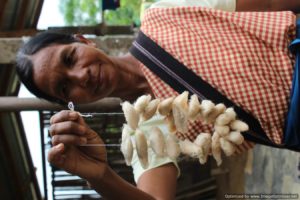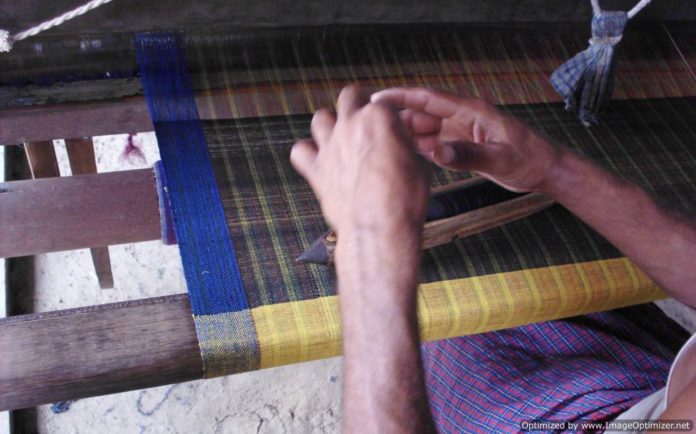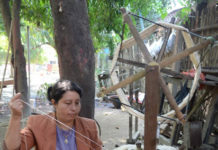The use of silk for weaving in India can be traced back to the third millennia BCE. While domesticated mulberry silk was introduced into India at a much later date, it was the wild silk varieties– tussar, muga and eri—that were being woven in ancient times. These varieties of wild silk remain indigenous to the East and North-East of the country.
Bhagalpur in Bihar is known as the tussar capital of the world as it is home to over 30,000 spinners, dyers and handloom weavers. The flat coppery yarn of the Antheraea Mylitta Paphia is woven into saris, stoles, home furnishing and piece goods for the domestic and overseas markets. Woven on pit-looms, the silk also known as kosa is valued for its natural heavy uneven textures and the luminous hues of colors created when dyed onto the coppery yarn.
 The gold muga silk spun from the antheraea assamensis is sourced mainly from Assam. This high value yarn recognized for its gleaming color, durability and strength was in the time of the Ahom Dynasty (1228-1862) reserved for the use of only the royal family and nobility. Now available for wider consumption, its weaves are considered essential wear at rituals and ceremonies. Hand woven mainly by women weavers in Sualkuchi on fly-shuttle and throw-shuttle looms, the textiles and motifs created are based on Assamese dress traditions.
The gold muga silk spun from the antheraea assamensis is sourced mainly from Assam. This high value yarn recognized for its gleaming color, durability and strength was in the time of the Ahom Dynasty (1228-1862) reserved for the use of only the royal family and nobility. Now available for wider consumption, its weaves are considered essential wear at rituals and ceremonies. Hand woven mainly by women weavers in Sualkuchi on fly-shuttle and throw-shuttle looms, the textiles and motifs created are based on Assamese dress traditions.
 Eri silk is indigenous to the North-East of India eri. It is spun from the Philosamia Cynthia ricini and woven largely by women on fly-shuttle frame looms. Unlike the other wild silks, the eri moth emerges live from the cocoon, making eri clothing appropriate wear for Hindu, Jain and Buddhist monks. Also called the Ahimsa or non-violent peace silk, the yarn is not reeled, but spun a quality that imparts warmth to the final woven textile.
Eri silk is indigenous to the North-East of India eri. It is spun from the Philosamia Cynthia ricini and woven largely by women on fly-shuttle frame looms. Unlike the other wild silks, the eri moth emerges live from the cocoon, making eri clothing appropriate wear for Hindu, Jain and Buddhist monks. Also called the Ahimsa or non-violent peace silk, the yarn is not reeled, but spun a quality that imparts warmth to the final woven textile.





